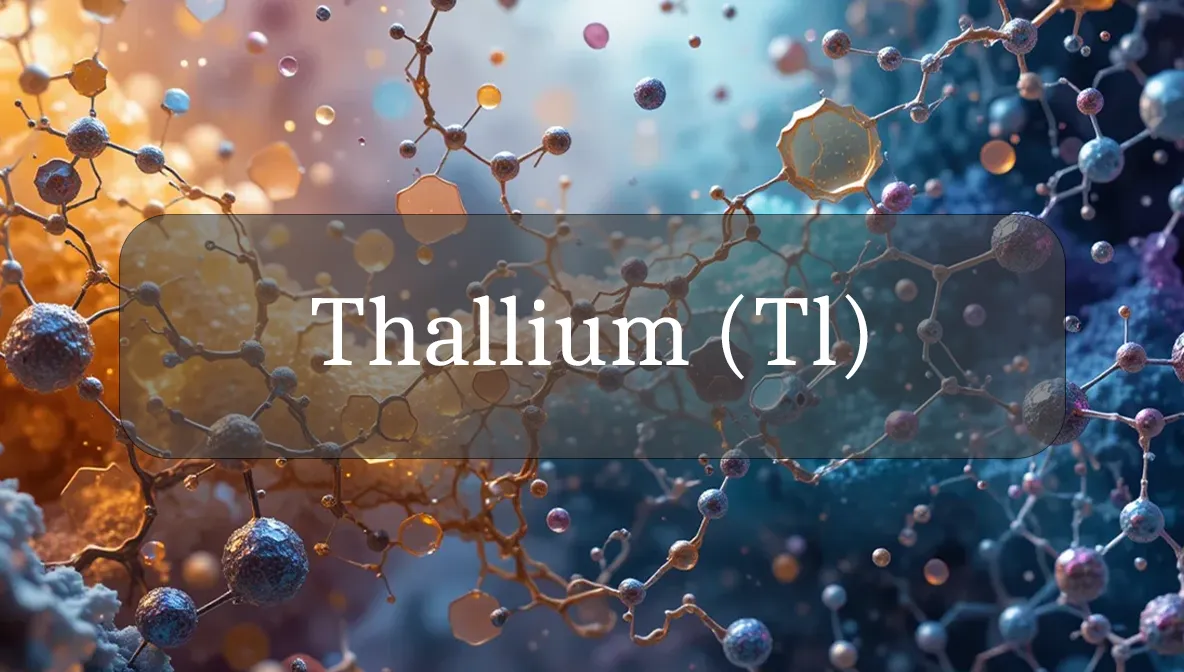Toxic Element to Steer Clear Of
Thallium (Tl) is a rare metal you’re unlikely to encounter in daily life, but it’s one to avoid at all costs due to its toxicity. Unlike beneficial minerals like calcium, thallium has no positive role in your body and can cause serious harm if you’re exposed to it. Let’s dive into what thallium is, its health impacts, and how to protect yourself while focusing on your wellness.
Chemical Identity and Role
Thallium is a soft, bluish-white heavy metal, atomic number 81 on the periodic table. It’s naturally found in trace amounts in the Earth’s crust and used in limited industrial applications, like electronics, glass manufacturing, and historically in rat poisons (now banned in many countries). In the body, thallium has no biological function and is highly toxic, interfering with vital processes by mimicking essential minerals like potassium.
Biological Role and Health Impact
Thallium is harmful rather than helpful, with no beneficial role in humans:
- Toxicity: Thallium disrupts cell function by replacing potassium in enzymes, leading to widespread damage in nerves, muscles, and organs.
- Nervous System Damage: It can cause neurological issues, like tingling, numbness, or severe pain in extremities, and in high doses, confusion or coma.
- Hair Loss: A hallmark of thallium poisoning is rapid hair loss, often within days of exposure.
- Organ Damage: It can harm the heart, kidneys, liver, and digestive system, causing symptoms like irregular heartbeat, kidney failure, or severe nausea.
- Cancer Risk: Chronic low-level exposure is potentially carcinogenic, though human data is limited.
The goal is to minimize exposure to thallium to safeguard your health and vitality.
Sources (Dietary or Environmental)
Thallium isn’t a dietary concern, as it’s not naturally present in significant amounts in food or water. Exposure typically comes from:
- Environmental Contamination: Thallium may be found in soil, water, or air near mining sites, coal-burning power plants, or industrial facilities processing thallium-containing ores.
- Occupational Exposure: Workers in electronics, glass, or cement industries may encounter thallium dust or fumes, though strict regulations limit this risk.
- Accidental or Intentional Exposure: Rare cases involve contaminated food, water, or intentional poisoning (thallium’s historical use as a poison makes it infamous).
- Foods: Trace amounts may be present in some vegetables (like kale or beets) grown in thallium-rich soils, but levels are typically too low to cause harm.
- Old Products: Antique glassware or banned pesticides may contain thallium, but these are rare sources today.
For most people, thallium exposure is negligible unless living near contaminated sites or working in specific industries.
Deficiency/Excess Signs
Thallium isn’t needed by the body, so there’s no “deficiency.” Exposure, even in small amounts, can cause:
- Acute Exposure (High Levels):
- Nausea, vomiting, or abdominal pain within hours.
- Tingling or burning in hands and feet, progressing to numbness or pain.
- Rapid hair loss (within 1–3 weeks).
- Irregular heartbeat, confusion, or seizures in severe cases.
- Chronic Exposure (Low Levels Over Time):
- Fatigue, weakness, or mild neurological symptoms (e.g., tremors).
- Slow hair thinning or skin changes.
- Kidney or liver issues, detectable through blood tests. If you suspect thallium exposure (e.g., unusual symptoms after working in a high-risk area), seek medical help immediately, as poisoning requires urgent treatment.
Supporting Optimal Levels
Since thallium is toxic, the focus is on avoiding exposure:
- Workplace Safety: If you work in industries using thallium, wear protective gear (respirators, gloves) and follow OSHA or local safety guidelines to prevent inhalation or skin contact.
- Environmental Awareness: Avoid areas near industrial sites or mines known for thallium contamination. Check local water quality reports if you live near such areas.
- Healthy Diet: Eating nutrient-rich foods (fruits, veggies, whole grains) supports your body’s natural detox systems, though they can’t fully counteract thallium poisoning.
- Medical Monitoring: If you’re at risk (e.g., occupational exposure), ask your doctor about periodic blood or urine tests to detect thallium early.
- Avoid Suspicious Sources: Be cautious with imported or antique products (e.g., glassware) that might contain trace thallium, though this is rare.
Safety, Interactions, and Precautions
Thallium requires strict precautions to avoid health risks:
- Inhalation and Ingestion Risk: Never handle thallium compounds without proper protection, as dust or fumes are highly toxic. Avoid eating or drinking near contaminated areas.
- Skin Contact: Thallium can be absorbed through skin, so wear gloves and wash thoroughly if exposure is possible.
- Medical Conditions: People with kidney, liver, or neurological conditions may be more vulnerable to thallium’s effects.
- Emergency Response: If thallium poisoning is suspected, seek immediate medical care. Treatments like Prussian blue (a detox agent) can bind thallium and help remove it from the body.
- Regulatory Protections: Ensure workplaces comply with regulations limiting thallium exposure (e.g., EPA or WHO guidelines).
If you experience symptoms like hair loss, nerve pain, or nausea after possible exposure, contact a poison control center or doctor right away.
Fun Fact
Did you know thallium was once called the “poisoner’s poison” because it’s odorless, tasteless, and was used in detective novels as a sneaky murder weapon? Thankfully, its use in poisons is now heavily restricted, keeping us safe from its dark past!
Citations
- National Institutes of Health (NIH): Toxicology of Thallium.
- Agency for Toxic Substances and Disease Registry (ATSDR): Thallium Public Health Statement.
- Mayo Clinic: Heavy Metal Poisoning Overview.
- Environmental Protection Agency (EPA): Thallium in the Environment.
- World Health Organization (WHO): Chemical Safety – Thallium Exposure.

